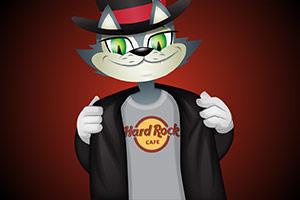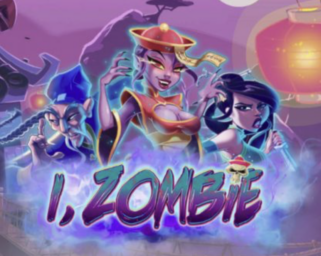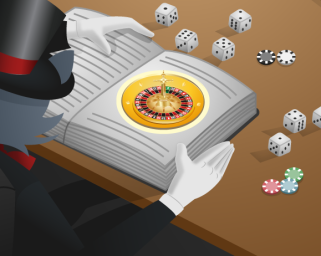Two American guys living in London in the 70s really missed the all-American burger. So they opened up a little joint called the Hard Rock Café. A half century later, the Hard Rock brand has grown to become one of the most recognizable names in the world. There are over 200 Hard Rock Cafes, Hotels, and Casinos operating all over the world.
But how does a single burger joint grow to become a major force in the casino world? That story involves a long road trip through American culture, global music, rock memorabilia, and an Indian tribe from Florida. And the rest, as they say, is history.
The Right Place at the Right Time

London in the early 1970s was at the epicenter of a major shift in fashion and musical tastes. Rock and roll music found its roots in 50s America. But it grew wings in the 60s British Invasion. British teens who grew up listening to American rock and roll put their own spin on it. They followed British bands like The Beatles, The Who, The Kinks, The Rolling Stones, and many more.
Following in the footsteps of San Francisco’s free-spirited youth scene, London of the 70s was at the forefront of European youth culture. One day, 2 wild-haired Americans named Isaac Tigrett and Peter Morton decided to open a rock-and-roll themed, American burger joint in the Mayfair district of London. They were planting the seeds of a major cultural icon.
The large motto written on the walls was simple yet powerful: Love All – Serve All. Derived from teachings from Tigrett’s guru, this 70s youth culture mantra echoed the American civil rights movement of the 60s. When combined with a ‘class-based’ British society, the Hard Rock Café was an instant success. Some credit the Hard Rock Café as being one of the first ‘classless’ places to hang out and eat. People from all walks of life could enjoy burgers and rock tunes in a funky, eclectic environment.
A Piece of Rock n Roll History

At first, the Hard Rock Café in London boasted an edgy, eclectic vibe in its décor and service. Soon certain rock and roll ‘royalty’ began to haunt the Café. It soon started its legendary journey to become the world’s largest rock and roll memorabilia museum—with one guitar.
Eric Clapton’s success with The Yardbirds and Cream didn’t stop him from wanting to grab a juicy burger from time to time. As a regular of the London Hard Rock Café, he offered the management one of his guitars. When they said they couldn’t play guitar, Clapton suggested that they hang it on the wall over his favorite booth to reserve his spot.
And with that first piece of rock and roll history mounted on the wall, the museum of memorabilia began to grow. Soon, Pete Townshend of The Who offered one of his guitars, with a hand-written note stating “Mine’s as good as his! Love, Pete.”
From there, the walls quickly filled with gifts of memorabilia from rock legends. Soon the rock swag became the signature feature of the Hard Rock brand. As the brand grew and new locations opened, the walls of the Hard Rock Cafes of the world were always filled with unique pieces of rock and roll history, from Clapton’s first guitar gift to the studded jumpsuits of Elvis, and everything in between.
The owners continued to receive donations of memorabilia. They also purchased even more at auctions over the years. Currently, with over 80,000 pieces, the Hard Rock Café houses the largest private collection of rock and roll memorabilia in the world.
Andy Warhol dubbed the Hard Rock Café ‘the Smithsonian of Rock & Roll.’
A Recipe for Success
Music has always been at the forefront of the Hard Rock Café experience, and they have never been shy about playing loud rock music through the years. Far from background music, the never-ending rock soundtrack playing prominently while you eat is part of the fun vibe—and part of the recipe for success.
In the early days of the London HRC, the reverence and devotion to the music even led to legendary gigs. In fact, an upstart former Beatle named Paul McCartney spread his solo wings at the London HRC, where he debuted his new band, Paul McCartney and Wings. It was the first live concert performance at Hard Rock Café.
Wearing the Culture

The famous Hard Rock Café t-shirts came about quite by accident. They originally made t-shirts emblazoned with their iconic logo for a local London soccer team. They sold the extras at the Café, and they quickly became a hit. Soon, they set up a separate stand to sell the t-shirts, which went on to become a wearable souvenir, further spreading the Hard Rock word.
As Hard Rock restaurants started sprouting up all around the world, it soon became desirable to wear a unique piece of each Café and its home city. Since the city-branded t-shirts could only be bought at each specific store, they became especially desirable. Fans young and old could be seen wandering the streets with brand new or threadbare HRC shirts from exotic sites like Hard Rock Café Honolulu or Hard Rock Café Beirut.
Selling the Hard Rock Café Name

Starting with their flagship t-shirts, Hard Rock Café branches opened a Rock Shop to sell a wide variety of souvenirs. Collectible pins, mugs, caps, hoodies, socks, and many more items adorned the racks. And as the brand grew in popularity, so did its worth.
Many HRC branches have opened over the years, and many have also closed. But when one location closes, another HRC springs up somewhere else. Eventually, the company expanded so much they became a very desirable business opportunity for investors.
When founder Peter Morton opened the Hard Rock Hotel in Las Vegas, this signaled expansion into other territories. Eventually, the Hard Rock brand was divided into corporate ownership over territories. The Hard Rock naming rights resided in 3 main properties: U.S. properties west of the Mississippi, east of the Mississippi, and international properties. Various properties were sold to hotel and leisure groups (Morgans Hotel Group and The Rank Group). Soon, an unexpected change in ownership was just over the horizon.
The Seminole Indian Tribe
Alongside the expansion trail of Hard Rock’s journey, the Seminole Indian Tribe of Florida was slowly writing their own corporate success story through their casinos. The Seminoles were the first Indian tribe to open casinos on Indian reservations in the United States.
In 1975, the Seminoles began operating a tax-free cigarette shop and high-stakes bingo operation on their Hollywood Reservation in Florida. Soon, the profits began rolling in, and they continued to develop tribal gaming on their various lands in Florida. After decades of gaming income grew into billions, the tribe was poised to make their largest acquisition to date: the purchase of the Hard Rock Café franchise.
In 2007, the Seminoles bought the Hard Rock Café brand for nearly $1 billion. After years of experience with tribal gaming, the new Hard Rock International began operating hotel casinos in various locations.
Currently, Hard Rock International is forming partnerships with other Indian tribes around the U.S. in order to open more Hard Rock Hotel Casinos. Construction on the Hard Rock Hotel & Casino at Fire Mountain near Sacramento, CA is nearly complete. To further position themselves in the heart of the California gambling industry, the company recently announced their plans to partner with the Tejon tribe in Kern County. The Hard Rock Hotel & Casino Tejon will be located south of Bakersfield, California, on 300 acres of reservation land.
After decades of delicious burgers served with love to all, what can you expect from a Hard Rock Casino? Resort casinos have always had a theme, from the Roman Empire décor of Caesars Palace to the Old World European glitz of the Bellagio. But with a Hard Rock Casino, the theme comes with the name.
And the human race never seems to outgrow its need for juicy burgers, lively music, and gambling action.










